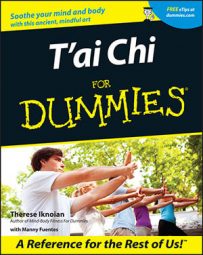Most people who know a little about T’ai Chi think of its movements, called forms. But T’ai Chi isn't just about moving in interesting ways with your body (making the shapes of T'ai Chi). You actually build on the principles of mindful movement so you can gain healthful benefits.
Every movement in T’ai Chi has its origin in some martial application. Sure, the movements look pretty. They flow. They look graceful. But behind the curtain of beauty, the movements are self-defense applications. Knowing this information can help you learn the movements even if you never plan to do combat with them, because you know why you pull back or why you place a hand in front of your face.
Focusing on T'ai Chi forms
Learning a single move in isolation is one thing. But learning an entire series of forms (or movements) that make up an entire sequence is an entirely different thing. Imagine learning the waltz. You pick up one box step just dandy. But what happens when you want not only to string together a whole bunch of steps but also to flow while you're doing them? To find the flow in T’ai Chi — as in waltzing — and the energy needed to achieve it, you need to learn entire sequences, not just one itty-bitty step in isolation.
Of course, you don't need to learn all the steps at once! T’ai Chi is a lifetime practice. But if you aren't ready to dedicate your life, you can practice a few minutes every few days or an hour or two a week so you can learn the techniques of the forms and their sequencing.
The forms are your alphabet, and after they become linked, they are your T’ai Chi vocabulary. All together, the forms are indispensable for developing balance, honing coordination, and building strength. They also help you move the chi within your body. Forms help you fine-tune the energy flow that helps unblock chi in your body.
Practicing the principles of T'ai Chi
Forms also provide an excellent vehicle for learning to apply the principles of T’ai Chi. Although you may come to T'ai Chi for the movement, you may find that you want stay for the principles and the internal changes that you experience. Nothing gives you a better chance to work on the principles than the forms.
Knowledge of the forms is essential to learning to move with the physical and mental relaxation that T’ai Chi requires. You can’t practice good T’ai Chi — physically or mindfully — while making a mental shopping list or worrying about your next project at work.
Training in forms lays a sound physical and mental foundation for everything you do in T’ai Chi. It allows you to work on the opening of the joints, the stretching of the muscles, and the development of song (pronounced sung). Song refers to relaxing and sinking your body lower. Maintaining mental focus ensures that the mind and body work together harmoniously.

